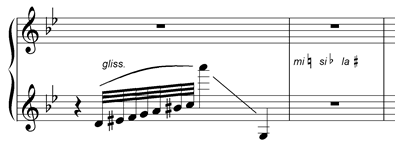What is the meaning of the straight lines between notes in opposite staves, as shown in the picture? I keep seeing it, but Google and Wikipedia are not helping me.
-
1I just have to ask, where did this music come from? I keep seeing questions like this with such terrible formatting.– MattPutnamCommented Feb 16, 2016 at 23:48
-
1At a guess, this is from the Ricercar a 6 from the Musical Offering, @MattPutnam. That is why the "surplus" of rests. To be fair, this would be a very difficult piece to format on a Grand Staff.– user16935Commented Feb 17, 2016 at 0:54
3 Answers
It means quite simply that the voice in question is moving between the staves (and usually between the hands as well). In this case, the voice starting with G above middle C falls an octave to be continued in the left hand until it returns to G below middle C, then rises back up an octave to be played in the right hand.
Edit: Here is the original score of this passage (m.10ff of the Ricercar a 6 from the Musical Offering). Looking at the range of the individual voices, you can well imagine the number of times voices will cross between staves when this is transcribed to a Grand Staff.
In Barbershop style notation, such a line indicates that the melody is moving from one voice part to another. By convention, a voice part does not move from one staff to the other.
In this case, it looks as if one musical line (perhaps on a single-note instrument or voice) moves from the treble clef staff to the base clef staff and then back. As a singer, I would find this confusing.
If it is for piano then it could be considered to be a Glissandi or Glissando. What guitar players know as a slide.
An example of how this is notated.
-
Glissando can be applied to other instruments, right? Besides that, gliss is what came to my mind as well. +1 Commented Mar 6, 2016 at 13:18
-
8It could be a glissando (which is normally specified with gliss. over the line), but in this case it isn't; it's voice crossings. I've added the original score to my answer so you can see how the voices were originally notated.– user16935Commented Mar 6, 2016 at 13:27
-
1Isn't glissando meant to be a wavy line, not a straight line connecting cleft. I believe it's moving voices. Commented Dec 19, 2016 at 3:56




